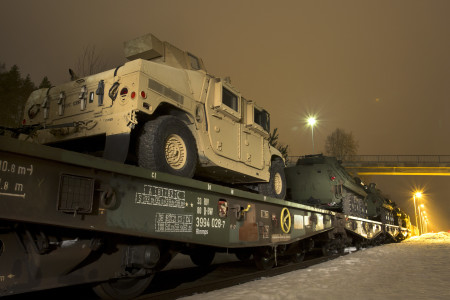
One of several transportation options for moving U.S. Marine Corps fighting vehicles and equipment is by train. Rena, Norway was the location where Light Armored Vehicles were loaded after training with the Telemark Battalion. The crews are now trained and the vehicles have been tested in harsh winter conditions. They will join the host nation of Norway along with the other 10 participating nations for Exercise Cold Response set to begin on the 29th. The exercise will feature maritime, land, and air operations to underscore NATO’s ability to defend against any threat in any environment. The location in central Norway provides a unique, extreme cold-weather environment for all forces involved to develop tactics, techniques, and procedures and learn from one another.
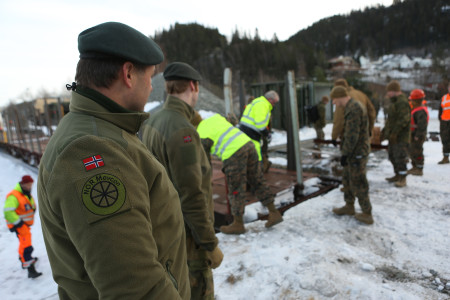
Norwegian officers from their movement control unit supervise the rail operations as U.S. Marines prepare the loading ramp to drive armored vehicles on train cars. Rail cars are one of several transportation options used to move U.S. Marine Corps fighting vehicles and equipment throughout the region. Hell, Norway was the location where HMMWVs and other vehicles were loaded and transported to the location where they would train with the Telemark Battalion. Cold Response 16 improves capabilities between NATO allies and partners and creates a foundation for future cooperation. This exercise enables the NATO alliance to work together and demonstrate both our unwavering commitment to our collective defense under the North Atlantic Treaty and our ability to counter transnational threats.
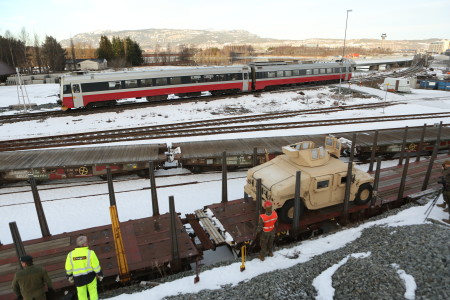
Rail cars are one of several transportation options used to move U.S. Marine Corps fighting vehicles and equipment throughout the region. Hell, Norway was the location where HMMWVs and other vehicles were loaded and transported to the location where they would train with the Telemark Battalion. Cold Response 16 improves capabilities between NATO allies and partners and creates a foundation for future cooperation. This exercise enables the NATO alliance to work together and demonstrate both our unwavering commitment to our collective defense under the North Atlantic Treaty and our ability to counter transnational threats.
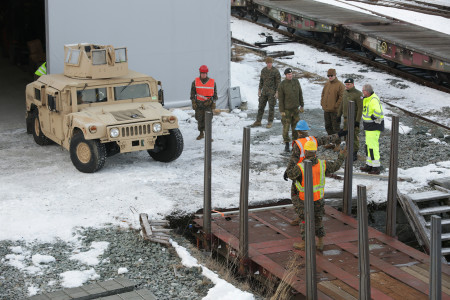
Norwegian officers from their movement control unit supervise the rail operations as U.S. Marines prepare the loading ramp to drive armored vehicles on train cars. Rail cars are one of several transportation options used to move U.S. Marine Corps fighting vehicles and equipment throughout the region. Hell, Norway was the location where HMMWVs and other vehicles were loaded and transported to the location where they would train with the Telemark Battalion. Cold Response 16 improves capabilities between NATO allies and partners and creates a foundation for future cooperation. This exercise enables the NATO alliance to work together and demonstrate both our unwavering commitment to our collective defense under the North Atlantic Treaty and our ability to counter transnational threats.
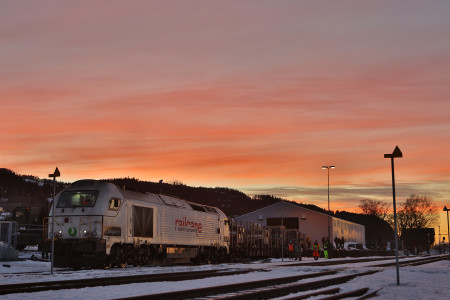
Rail cars are one of several transportation options used to move U.S. Marine Corps fighting vehicles and equipment throughout the region. Hell, Norway was the location where HMMWVs and other vehicles were loaded and transported to the location where they would train with the Telemark Battalion. Cold Response 16 improves capabilities between NATO allies and partners and creates a foundation for future cooperation. This exercise enables the NATO alliance to work together and demonstrate both our unwavering commitment to our collective defense under the North Atlantic Treaty and our ability to counter transnational threats.
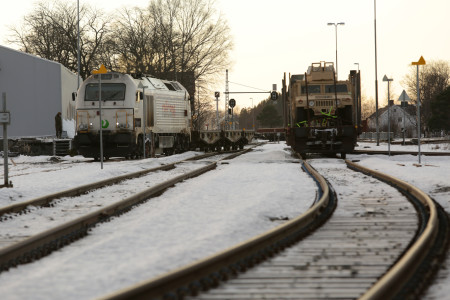
Rail cars are one of several transportation options used to move U.S. Marine Corps fighting vehicles and equipment throughout the region. Hell, Norway was the location where HMMWVs and other vehicles were loaded and transported to the location where they would train with the Telemark Battalion. Cold Response 16 improves capabilities between NATO allies and partners and creates a foundation for future cooperation. This exercise enables the NATO alliance to work together and demonstrate both our unwavering commitment to our collective defense under the North Atlantic Treaty and our ability to counter transnational threats.
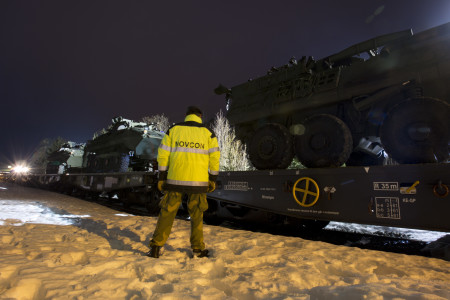
A Norwegian soldier from the Home Guard supervises the loading process of several Light Armored Vheicles and other heavy equipment in Rena, Norway. One of several transportation options for moving U.S. Marine Corps fighting vehicles and equipment is by train. Rena, Norway was the location where Light Armored Vehicles were loaded after training with the Telemark Battalion. The crews are now trained and the vehicles have been tested in harsh winter conditions. They will join the host nation of Norway along with the other 10 participating nations for Exercise Cold Response set to begin on the 29th. The exercise will feature maritime, land, and air operations to underscore NATO’s ability to defend against any threat in any environment. The location in central Norway provides a unique, extreme cold-weather environment for all forces involved to develop tactics, techniques, and procedures and learn from one another.
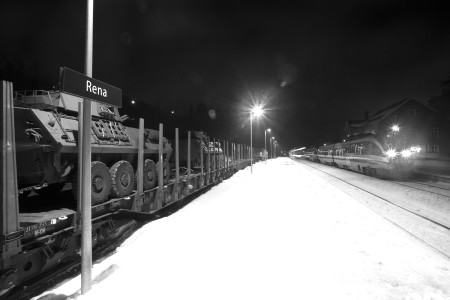
One of several transportation options for moving U.S. Marine Corps fighting vehicles and equipment is by train. Rena, Norway was the location where Light Armored Vehicles were loaded after training with the Telemark Battalion. The crews are now trained and the vehicles have been tested in harsh winter conditions. They will join the host nation of Norway along with the other 10 participating nations for Exercise Cold Response set to begin on the 29th. The exercise will feature maritime, land, and air operations to underscore NATO’s ability to defend against any threat in any environment. The location in central Norway provides a unique, extreme cold-weather environment for all forces involved to develop tactics, techniques, and procedures and learn from one another.